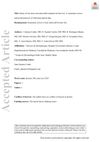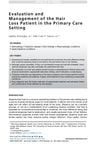6 months on dutast and minoxodil, hair growing like weeds now! Progress Pictures 7/12/2025
A woman experienced significant hair regrowth after six months of using dutasteride and minoxidil, despite initial hair loss due to androgenetic alopecia. She reported minimal side effects and highlighted the effectiveness of these treatments for women, despite doctors' hesitancy to prescribe them.
View this post in the Community →
Similar Community Posts Join
6 / 1000+ resultscommunity Reddit’s amatorial meta analysis of 17 already avaliable hair loss prevention treatments that were found to be effective in clinical studies but are not FDA approved for MPB. PROS and CONS. (2022 Guide if Finasteride and Minoxidil are not working/ give you sides/are not enough) 77 studies linked!
The post and conversation are about hair loss treatments that have been found to be effective in studies. There are 19 different treatments mentioned, including oral minoxidil, oral dutasteride, topical finasteride, RU58841, and more. The best treatment for an individual depends on factors like availability, cost, side effects, and personal preferences.
community Dermatologist says you can’t prevent hair loss and medications don’t work
Finasteride, dutasteride, and minoxidil can help prevent or slow hair loss for many, though results vary. The dermatologist's claim that no medication works is incorrect, as these treatments are effective for some individuals.
community 15 months total on Dut/Min/RU and microneedling 1mm every other week
The user reported significant hair improvement over 15 months using dutasteride, minoxidil (oral and topical), RU58841, ketoconazole, and microneedling. They are considering a hair transplant in 4-6 months.

community Thinning in Hairline and Vertex - What do I do?
A 25-year-old male is experiencing hair thinning at the hairline and vertex, considering using a dermapen or dermastamp, and seeking advice on whether to continue with natural remedies like onion juice and rosemary oil or start using minoxidil or finasteride. He is also looking for recommendations on microneedling devices.
community Convinced dad to get into minox 3 months ago and fin 2 months ago
A user convinced their 45-year-old dad to use minoxidil and finasteride, resulting in significant hair regrowth. The dad now uses 1mg of finasteride daily and topical minoxidil twice a day, and has also started using 1% ketoconazole shampoo.
community COMPLETE OVERVIEW of the Treatment of androgenetic alopecia in men
Male androgenetic alopecia is commonly treated with topical minoxidil and oral finasteride, both requiring continuous use. Other options include hair restoration surgery, dutasteride, light therapy, and camouflaging agents.
Related Research
6 / 1000+ results
research The Efficacy and Safety of Finasteride Combined with Topical Minoxidil for Androgenetic Alopecia: A Systematic Review and Meta-Analysis
Finasteride and minoxidil together safely and effectively increase hair growth and density for androgenetic alopecia.

research Safety of Low-Dose Oral Minoxidil Treatment for Hair Loss: A Systematic Review and Pooled Analysis of Individual Patient Data
Low-dose oral minoxidil is a safe treatment for hair loss, with the main side effect being excessive hair growth. Other side effects like foot swelling, low blood pressure when standing, and heart rate changes are rare.
research Effectiveness and Safety of Combined Therapy with Oral Minoxidil, Oral Dutasteride, and Mesotherapy with Dutasteride in Real Clinical Practice
The combination of oral minoxidil, oral dutasteride, and mesotherapy is the most effective and safe for hair growth in AGA.

research Androgenetic Alopecia: Therapy Update
There are many treatments for common hair loss, but more trials are needed to decide which are best.

research Mesotherapy as a Promising Alternative to Minoxidil for Androgenetic Alopecia: A Systematic Review
Mesotherapy is a promising alternative to minoxidil for hair loss with mild side effects.

research Evaluation and Management of the Hair Loss Patient in the Primary Care Setting
Doctors should diagnose hair loss by examining the patient and possibly doing tests, and then treat it based on the type, which may prevent permanent hair loss.